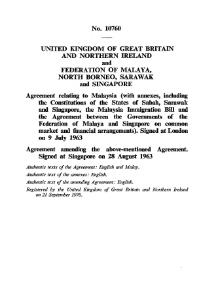| Malaysia Bill of Agreement relating to Malaysia between United Kingdom of Great Britain and Northern Ireland, Federation of Malaya, North Borneo, Sarawak and Singapore | |
|---|---|
 Malaysia Bill of the Agreement relating to Malaysia | |
| Drafted | 15 November 1961 |
| Signed | 9 July 1963 |
| Location | London, United Kingdom |
| Sealed | 31 July 1963 |
| Effective | 16 September 1963 |
| Signatories | |
| Parties |
|
| Depositary | British Government dated 21 September 1970 The Secretary-General of the (English), (French), and (Malay) Registered Nr. I-10760 |
| Languages | English and Malay |
| Full text | |
The Malaysia Bill is an annex of the Agreement relating to Malaysia between United Kingdom of Great Britain and Northern Ireland, Federation of Malaya, North Borneo, Sarawak and Singapore. It gave effect to the Agreement where that the British colonies of North Borneo, Sarawak and the State of Singapore should be federated with the existing States of the Federation of Malaya and the name of the federation should be Malaysia, [2] and the Federal constitution wherewith to amend and adopt the Constitution of the Federation of Malaya so as to provide for the admission of those States. it adopted its present name, the name of the Constitution of the Federation of Malaya should be changed into Constitution of Malaysia. [3] [4]
